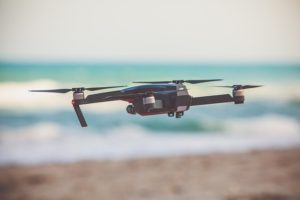The FAA has released the Remote ID for Drones final rule along with a rule on operations over people and moving vehicles, and night operations. The long-awaited publications will clarify the details of Remote ID, and allow stakeholders from the commercial and recreational drone communities to begin to prepare for implementation – while expanding the scope of commercial operations with clear regulations on Operations Over People. Find the full text of the Remote ID for Drones Rule here; the text of the Operations Over People Rule here.
At its simplest, Remote ID for Drones, or RID, would allow authorized people to identify any drone in the airspace and connect them with a pilot, much like an automobile license plate identifies a vehicle and that vehicle’s owner.
Summary of the Final Rule on Remote ID: No Network-Based Remote ID Requirement
According to the FAA announcement:
The Remote ID rule applies to all operators of drones that require FAA registration. There are three ways to comply with the operational requirements:
- Operate a standard Remote ID drone that broadcasts identification and location information of the drone and control station;
- Operate a drone with a Remote ID broadcast module (may be a separate device attached to the drone), which broadcasts identification, location, and take-off information; or
- Operate a drone without Remote ID but at specific FAA-recognized identification areas.
What is not in the current rule is a requirement for Network-based Remote ID.
“In response to the NPRM, the FAA received significant feedback about the network requirement identifying both public opposition to, and technical challenges with, implementing the network requirements,” says the text of the final rule. “The FAA had not foreseen or accounted for many of these challenges when it proposed using the network solution and USS framework. After careful consideration of these challenges, informed by public comment, the FAA decided to eliminate the requirement in this rulemaking to transmit remote identification messages through an Internet connection to a Remote ID USS.”
“These final rules carefully address safety, security and privacy concerns while advancing opportunities for innovation and utilization of drone technology,” said U.S. Secretary of Transportation Elaine L. Chao.
Remote ID: From Prosed Rule Making to Final Rule
In December of 2019, the FAA released the original proposal – the Notice of Proposed Rule Making (NPRM). In the three months allowed, the FAA received more than 50,000 comments. (See this article for more details on the NPRM.) While some stakeholders welcomed the rule, others said that the rule required “essential changes” to make the rule less burdensome.
The NPRM text can be found here. Details effect many stakeholders in the drone industry, from recreational and commercial pilots to drone manufacturers and law enforcement agencies.
In May 2020, the FAA decided to work on technology requirements at the same time as they evaluated the comments and finalized the rule. At that time, the FAA announced 8 partners to work with the FAA in setting up “a framework of technology requirements for future suppliers of remote ID technology.” The 8 companies chosen were: Airbus, AirMap, Amazon, Intel, One Sky, Skyward, T-Mobile, and Wing.
Now, the FAA has kept their promise of release before the end of the year for both Remote ID and Ops Over People.
Ops Over People (and Moving Vehicles) and Night Operations
With Remote ID out of the way, Operations Over People and Operations at Night could also move forward. The Ops Over People Rule breaks eligible aircraft into 4 categories, as quoted below.
Category 1, Category 2, Category 3, and Category 4 Eligibility for operations over people
The final rule establishes four new categories of small unmanned aircraft for routine operations over people: Category 1, Category 2, Category 3, and Category 4. The final rule also allows for routine operations over moving vehicles.
- Category 1 eligible small unmanned aircraft must weigh less than 0.55, including everything on board or otherwise attached, and contain no exposed rotating parts that would lacerate human skin. No FAA-accepted Means of Compliance (MOC) or Declaration of Compliance (DOC) required.
- Category 2 eligible small unmanned aircraft must not cause injury to a human being that is equivalent to or greater than the severity of injury caused by a transfer of 11 foot-pounds of kinetic energy upon impact from a rigid object, does not contain any exposed rotating parts that could lacerate human skin upon impact with a human being, and does not contain any safety defects. Requires FAA-accepted means of compliance and FAA-accepted declaration of compliance.
- Category 3 eligible small unmanned aircraft must not cause injury to a human being that is equivalent to or greater than the severity of injury caused by a transfer of 25 foot-pounds of kinetic energy upon impact from a rigid object, does not contain any exposed rotating parts that could lacerate human skin upon impact with a human being, and does not contain any safety defects. Requires FAA-accepted means of compliance and FAA-accepted declaration of compliance.
- Category 4 eligible small unmanned aircraft must have an airworthiness certificate issued under Part 21 of FAA regulations. Must be operated in accordance with the operating limitations specified in the approved Flight Manual or as otherwise specified by the Administrator. The operating limitations must not prohibit operations over human beings. Must have maintenance, preventive maintenance, alterations, or inspections performed in accordance with specific requirements in the final rule.
Ops over people is a significant step forward for expanded operations like drone delivery, which become impracticable in urban areas without the ability to fly over people and moving vehicles. Night Ops will be allowed for certified operators with appropriate lighting.
Implementation
Drone manufacturers and pilots have some time to get ready to implement the new rules, which become effective 60 days after publication in the Federal Register. Drone manufacturers will then have 18 months to produce drones equipped with Remote ID technology, operators will have 1 year after that to start using drones with Remote ID.
ANRA Technologies is one of the companies that has been deeply involved in testing and evaluating components of Unmanned Traffic Management (UTM) systems. ANRA CEO Amit Ganjoo says that it will take some time for the drone industry to evaluate the rule in full and see how the Remote ID for drones final version differs from the version presented for comments in December of 2019. “This is a step in the right direction,” says Ganjoo. “We need to take the time to digest this information, unpack the details and see what this contains for all stakeholders – but now we can start to understand the impact that Remote ID for drones will have on the drone industry.”
“The new rules make way for the further integration of drones into our airspace by addressing safety and security concerns,” said FAA Administrator Steve Dickson. “They get us closer to the day when we will more routinely see drone operations such as the delivery of packages.”
Miriam McNabb is the Editor-in-Chief of DRONELIFE and CEO of JobForDrones, a professional drone services marketplace, and a fascinated observer of the emerging drone industry and the regulatory environment for drones. Miriam has penned over 3,000 articles focused on the commercial drone space and is an international speaker and recognized figure in the industry. Miriam has a degree from the University of Chicago and over 20 years of experience in high tech sales and marketing for new technologies.
For drone industry consulting or writing, Email Miriam.
TWITTER:@spaldingbarker
Subscribe to DroneLife here.
https://dronelife.com/2020/12/28/breaking-faa-publishes-remote-id-for-drones-final-version-ops-over-people/
 Unmanned Aerial Vehicle The latest drone news
Unmanned Aerial Vehicle The latest drone news





